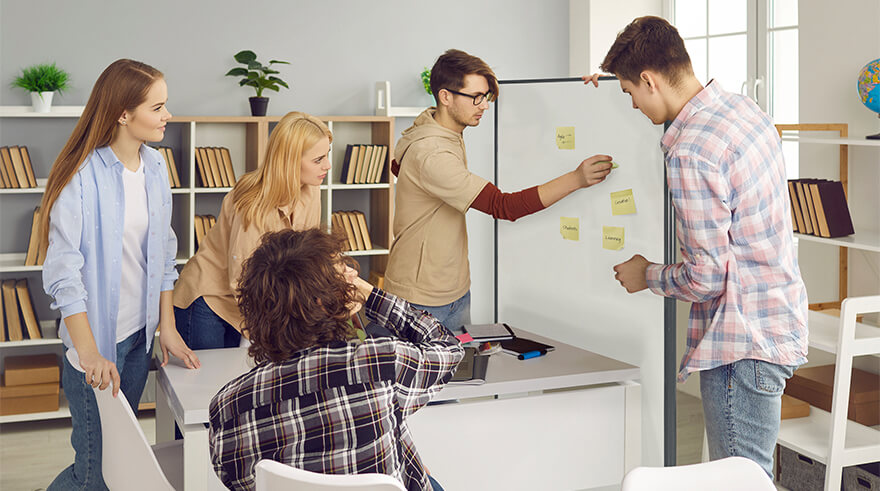Collaboration is a key part of any team. To build an effective self-organizing, multifunctional team you must be both creative and collaborative. It can be difficult to understand how creativity and teamwork are connected, but by figuring out this relationship you’ll be able to better work with everyone.
The importance of creativity can't be overstated . Organisations of all sizes need to find ways to encourage this kind of thinking to stay competitive. What does creativity actually mean, though? And how can we know for sure if an organization is successfully stimulating it?
Scientists have long been struggling with a definition of creativity. According to neuropsychologist Rex Jung, creativity is the creation of something that is both novel and useful. In his research, he found that some of the qualities that correlate with creativity are also qualities needed for effective teams, like, for example, humour.
Despite brainstorming being a good way to invite creativity, on its own is not enough. Creativity needs people working together to be successful. But when brainstorming, people aren’t supposed to criticize one another. This prevents many productive ideas from being generated and coming to fruition.

It's important to understand that to be creative, there should be a sense of comfort among the team. Conflict is inevitable, but it can be constructive if handled properly. To have a successful team, it's critical to recognise that trust is necessary and that the group should establish a dynamic where people can disagree, yet they understand that there is an underlying sense of trust.
A team working together is like a well-oiled machine. You need to keep it running smoothly, but you also need to make sure that it has space to grow and get inspired. Practices such as maintaining a sustainable pace, holding reviews and retrospectives, and giving team members time for creativity will help the team find new ways to improve.
Collaborative spaces help drive connections and creativity
Hierarchal organisations create silos and inhibit creativity. They're not encouraged to share their insights. An effective creative team needs a productive environment to thrive. This can sometimes happen on its own, but not always. Therefore, a creative work environment must be deliberate.
Spaces that encourage cross-functional collaboration are extremely important. They can help people share ideas, find creative solutions to problems, and be accountable to each other. This means that if a problem arises, one employee does not have to be stuck on the same task for days. Instead, the team can work together through things and improve the team’s morale.
Still, it can be tough to think about your office layout when you're in the middle of it all. That is why we have listed the characteristics of any workspace that can create a sense of collaboration for the people inside - even though there are many options, these are some of the most important.
Set up spaces for different needs
“Zoning” is an office design trend that boosts productivity and creativity by offering a variety of collaborative spaces. A small seating arrangement will be perfect for quick meetings or individual work, but larger groups will need a more private space with the proper furniture.
When it comes to offices, a common complaint is that there are never any meeting spaces available. And when one is finally freed up, somebody will book it in advance. Solve this problem by providing enough meeting areas for everyone to have one without requiring employees to book it well in advance.
Choose adequate seating furniture
To optimise a casual meeting space, make it as flexible as possible. The furniture should provide different seating options and plenty of soft seating. Make sure it is easy to rearrange so employees can adapt the space to suit the needs of the moment.
Booths are a popular choice for those looking for comfortable seating and privacy while doing work. Large enough to offer a workspace, booths preserve the privacy of customers while they do their work.
Include tools to share ideas
Crafting the perfect workspace is more than just the design of your office. To make sure you are catering to all types of meetings, think about the equipment needed for team collaboration.
To be effective, a collaborative workspace should have three important components: a whiteboard for brainstorming ideas, a smart screen for showing digital content, and a collaboration table for teams to work on.

Provide charging stations
With technology taking over day-to-day life, it is essential for businesses to have a plentiful supply of power outlets so employees can charge their laptops and mobile devices as they work. If there is not enough space for a power outlet, USB ports are an excellent alternative.
You don't want to be limited to charging your device during a meeting. That's why outlets near seating areas and integrated into tables are necessary. On that note, fast and reliable Wi-Fi is also a must.
Aesthetic experience and comfort
A well-designed and interesting space is a wonderful tool to inspire creativity in the workplace. This can be achieved through often overlooked elements, such as comfortable furniture, plants, and ample room for movement.
Choosing the right lighting and sound is just as important as colour schemes and design. For example, natural lighting is better than artificial when possible, and smart acoustic panels help to improve the soundscape.
These pointers will help teams do more than just communicate and get things done. They'll also help you create the workspace to support that goal.
Nevertheless, there are no one-size-fits-all solutions for workspaces today. So, poll your employees and find out what they prefer. They know what they need, and they can tell you if they're too far away from others or if it's hard to concentrate in the noise. Then, try to balance that with management's needs and wishes.
When everyone sees the benefits for themselves, they’ll be more inclined to accept the collaborative environment you establish and work better as a team.


.png)